RBSE Class 10 Science Important Questions Chapter 13 Magnetic Effects of Electric Current
Rajasthan Board RBSE Class 10 Science Important Questions Chapter 13 Magnetic Effects of Electric Current Important Questions and Answers.
Rajasthan Board RBSE Solutions for Class 10 Science in Hindi Medium & English Medium are part of RBSE Solutions for Class 10. Students can also read RBSE Class 10 Science Important Questions for exam preparation. Students can also go through RBSE Class 10 Science Notes to understand and remember the concepts easily. Browsing through class 10 science chapter 12 question answer in hindi that includes all questions presented in the textbook.
RBSE Class 10 Science Chapter 13 Important Questions Magnetic Effects of Electric Current
Objective Type Question
The direction of magnetic lines of force when current is induced in a conducting wire is -
(a) Perpendicular outside to the conductor
(b) Perpendicular inside to the conductor
(c) Equal
(d) Rectangular around the conductor
Answer:
(d) Rectangular around the conductor

Unit of Magnetic field is -
(a) Tesla
(b) Ampere
(c) Volt
(d) Tesla-meter
Answer:
(a) Tesla
The induced electric carrying force in the armature of a AC generator depends upon -
(a) Rotation of armature
(b) No. of turns of rings of armature
(c) Area of the armature
(d) All of the above
Answer:
(d) All of the above
Magnetic lines of force decides -
(a) Size of the magnetic field
(b) Direction of magnetic field
(c ) Effect of magnetic field
(d) Both (b) and (c)
Answer:
(d) Both (b) and (c)
Who discovered the relationship between electricity and magnetism ?
(a) Newton
(b) Faraday
(c) Maxwell
(d) Oersted
Answer:
(d) Oersted
The potential difference between the live wire and neutral wire in an domestic electric circuit is -
(a) 20Q V
(b) 150 V
(c) 210 V
(d) 220 V
Answer:
(d) 220 V

Force of attraction between two different magnetic poles is ‘F' If the distance between these poles be double then what would be the force of attraction between them -
(a) F
(b)\(\frac{F}{2}\)
(c)\(\frac{\mathrm{F}}{4} \)
(d)\(\frac{\mathrm{F}}{8}\)
Aswer:
(c)\(\frac{\mathrm{F}}{4} \)
Frequency of domestic alternating current (AC) in India is -
(a) 0 (zero)
(b) 50 Hz
(c) 60 Hz
(d) 100 Hz
Answer:
(b) 50 Hz
What is the unit of magnetic field strength?
Answer:
The unit of magnetic field strength is ‘Oersted’.
What is ‘magnetic field’?
Answer:
The region surrounding a magnet, in which the force of the magnet can be detected, is said to have a magnetic field.

What are magnetic field lines? Ans. The lines that represent the magnetic field of a magnet are called magnetic field lines.
Answer:
The lines that represent the magnetic field of a magnet are called magnetic field lines.
What is the direction of magnetic field lines within a magnet?
Answer:
The direction of magnetic field lines within a magnet is from its south pole to the north pole.
What happens on connecting too many appliances at a time to a single socket?
Answer:
The circuit gets overloaded in this case.
How can the direction of magnetic field of a magnet at a point can be deter-mined?
Answer:
A compass needle is placed over that point of magnetic field. The north pole of the needle indicates the direction of magnetic field.
What is the direction of magnetic field lines ?
Answer:
Direction of magnetic field of a magnet is from north pole of a magnet towards the south pole in closed curves.
What happens when we kept a current carrying conductor over a compass needle ?
Answer:
There is a deflection in the arms of compass needle in such case. We can find out their direction with the help of SNOW rule.

What is SNOW rule ?
Answer:
If the direction of the current flowing through the wire is from south (S) to north (N) and the wire is placed over (O) the needle, the north pole of the needle is deflected towards west (W).
What happens when the direction of current is reversed in a current carrying conductor ?
Answer:
In this case the deflection in the compass needle will reverse.
If the direction of current flowing in a straight wire be reversed, can the direction of magnetic field will also be reversed ?
Answer:
Yes, the direction of magnetic field will also be reversed.
What does the concentric curve lines represents ?
Answer:
They represents the lines of magnetic field.
Give the difference between the nature of magnetic fields developed at the opposite points of a conducting loop.
Answer:
The direction of magnetic field lines is opposite at both the points. The magnetic field produced at these points are curved concentric rings.

The value of magnetic field developed in a conducting loop is maximum at which point ?
Answer:
The value is maximum at the centre.
What happens when a conducting wire is place in magnetic field ?
Answer:
A force is induced in it.
Write the name of that rule which gives the direction of force induced on a current carrying conductor in the magnetic field.
Answer:
Fleming’s left hand rule.
On what factors does the value of magnetic force depends ?
Answer:
- Value of magnetic field
- Length of conductor
- The current flowing in the conductor.
What happens when the direction of the current in the conductor kept in magnetic field be reversed ?
Answer:
The direction of magnetic force will also be reversed.
How is a uniform magnetic field represented ?
Answer:
A uniform magnetic field is represented by parallel and equidistant magnetic field lines.
What happens when a conducting coil is brought near another coil ?
Answer:
The current is induced in the other coil.
What is the magnitude of current in the second coil when uniform current flows in the first coil ?
Answer:
Zero.
What is the name of conducting coil and induced coil?
Answer:
Conducting coil is called primary coil and induced coil is called secondary coil.
Which is that coil in which magnetic field develops?
Answer:
Magnetic field develops from primary coil because it is the conducting coil.

On what factors does the strength of induced current in secondary coil depends?
Answer:
- Strength of current in primary coil.
- Number of turns of wires in primary coil.
What is magnetic flux ?
Answer:
The total magnetic lines of force passing perpendicular to the surface in a magnetic field are called magnetic flux. Its unit is weber.
What do you mean by electro-magnetic induction?
Answer:
It is the phenomenon of producing induced current in a closed circuit due to change in magnetic field in circuit.

An electric motor converts which energy into what?
Answer:
Electrical energy into mechanical energy.
What is the magnitude of the magnetic field generated by the coil with V turn in comparison to single turn?
Answer:
The magnitude will be times stronger.
What is a solenoid?
Answer:
A coil of many circular turns of insulated copper wire wrapped closely in the shape of a cylinder is called a solenoid.
Who presented the view of force on an electric current conductor in a magnetic field ?
Answer:
French scientist Andre Marie Ampere.
Name two main organs in the human body where the magnetic field produced is significant.
Answer:
Brain and Heart.
Give the full form of MRI.
Answer:
MRI stands for Magnetic Resonance Imaging.
What is a Commutator?
Answer:
A device that reverses the direction of flow of current through a circuit is called a commutator.

Who discovered ‘electromagnetic inductionr?
Answer:
Michael Faraday.
On what factors does the magnitude of induced electric current in a A.C. Generator depends ?
Answer:
It depends upon the no. of turns in coil, area of the coil, speed of rotation and intensity of magnetic field.
In a electromagnet the core is generally made up of?
Answer:
Soft Iron.
What is ‘armature’? What is its use?
Answer:
The soft iron core, on which the coil is round, plus the coils, is called an armature. This enhances the power of the motor. .
Write difference between electric motor and electric generator.
Answer:
Electric motor converts electrical energy into mechanical energy whereas electric generator converts mechanical energy into electrical energy.
Which electric current is used in battery charger?
Answer:
D.C. current.
Rating of a fuse wire is 15 A. What is the meaning of this line ?
Answer:
It means that in this circuit maximum of 15 A current can flow. If the value of current in the circuit exceeds 15 A then the fuse wire melts and the circuit will automatically open.

What is the role of scientist Hans Christian Oersted in explaining electromagnetism ?
Answer:
Hans Christian Oersted, one of the leading scientists of the 19th century, played a crucial role in understanding electro-magnetism. In 1820 he accidentally discovered that a compass needle got deflected when an electric current passed through a metallic wire placed nearby. Through this observation Oersted showed that electricity and magnetism were related phenomena. His research later created technologies such as the radio, television and fiber optics. The unit of magnetic field strength is named the Oersted in his honor.
What are magnetic field lines ? How does the direction of magnetic field decided at a given point?
Answer:
The space around a magnet where magnetic force of attraction or repulsion can be experienced by other magnetic substance is called magnetic field. Magnetic field lines are closed continuous curves. Magnetic field lines emerge from a magnet at N-pole and enter the magnet at S-pole. But magnetic field lines run from S-pole to N-pole within the magnet. It has both magnitude and direction hence it is vector quantity. The tangent at any point in the magnetic field lines gives the direction of the magnetic field at that point.
“Magnetic field lines are closed curves.” Explain.
Answer:
The direction of the magnetic field is taken to be the direction in which a north pole of the compass needle moves inside it. Therefore it is taken by convention that the field lines emerge from north pole and merge at the south pole. Inside the magnet, the direction of field lines is from its south pole to its north pole. Thus, the magnetic field lines are closed curves.
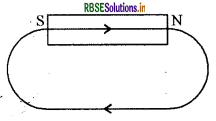
Magnetic field lines around a bar magnet are shown in the figure. A student states that magnetic field are strong at point A and weak at point B. Explain whether the statement is true or false.
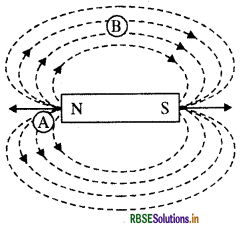
Answer:
The statement is true because the magnetic field is stronger at that place where the magnetic lines are closer and weak at that place where the magnetic lines are far.
Magnetic fields of two magnets are shown in fig (a) and (b). Which figure represents these lines in correct pattern. Write the names of those poles of magnet which are in front of each other.
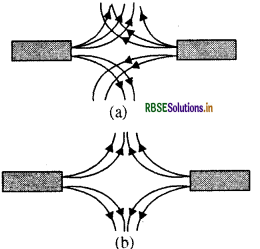
Answer:
Two magnetic field lines will never intersect each other, hence figure (b) shows the correct pattern of magnetic field lines. In figure both the ends of the magnet have north pole which are pointing each other, because the magnetic field of lines emerges from north pole.
If there is an increase in the number of turns in the circular coils made of electric current, then what will be the effect on the magnetic field generated ?
Answer:
The magnetic field produced by a current-carrying wire at a given point depends directly on the current passing through it.
Therefore, if there is a circular coil having n turns, the field produced is n times as large as that produced by a single turn. This is because the current in each circular turn has the same direction, and the field due to each turn then just adds up.

Write the features of commercial motors.
Answer:
The commercial motors are -
- an electromagnet in place of permanent magnet
- large number of turns of the con-ducting wire in the current-carrying coil; and
- a soft iron core on which the coil is wound.
- This enhances the power of the motor.
What is the direction of magnetic field at the points situated just above the wire and just below the wire produced due to electric current in an electric wire ?
Answer:

- Magnetic fields direction on the point above the wire is from south to north.
- Magnetic fields direction on the point below the wire is from north to south.
A current carrying coil is hanged in the air as shown in the figure. When it is seen from above, the current seems to flow in clockwise direction, but when seen from below, the current seems to flow in anticlockwise direction.
(i) Draw magnetic field lines that represents the magnetic field of the coil.
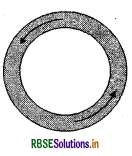
(ii) Give the names of poles on the upper surface and lower surface of the coil.
Answer:
(i) Magnetic field lines are shown in the diagram below -
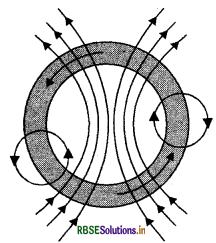
(ii) The upper surface of coil acts as north pole and the lower surface acts as south pole of the magnet.
Explain the use of magnetism in medicine.
Answer:
An electric current always produces a magnetic field. Even weak ion currents that travel along the nerve cells in our body produce magnetic fields. When we touch something, our nerves carry an electric impulse to the muscles we need to use. This impulse produces a temporary magnetic field. These fields are very weak and are about one-billionth of the earth’s magnetic field. Two main organs in the human body where the magnetic field produced is significant, are the heart and brain. The magnetic field inside the body forms the basis of obtaining the images of different body parts. This is done using a technique called Magnetic Resonance Imaging (MRI). Analysis of these images helps in medical diagnosis. Magnetism has, thus, got important uses in medicine.

Why does a current carrying conductor placed in magnetic field experiences a force ? What is the direction of force on the conductor ?
Answer:
In the current carrying conductor negatively charged particles (electrons) are in motion. In the magnetic field all these electrons experienced force. The force exerted on the electrons is the force experienced by the conductor. That is why a current carrying conductor placed in the magnetic field experienced a force. The direction of this force is perpendicular to both the magnetic field and the current in the conductor.
A proton enters a magnetic field at 90° angle. What is the direction of force on proton ?
Answer:
When a conductor carrying current is placed perpendicular to the direction of magnetic field, force acting on it is given by Fleming’s left hand rule. Since the direction of current is the same as that of the motion of a positive charge, the direction
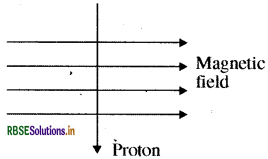
of force acting on it when moving perpendicular to the direction of magnetic field is the same as that acting on a current-carrying conductor placed perpendicular to the direction of. magnetic field. Obviously, the force acting on a proton is opposite to that, therefore in this case direction of the force acting on the proton is perpendicular to the surface of paper and is upward.
Two circular coils A and B are placed near to each other. If there is a change in the value of current in coil A, then is the current in B also change ? Explain it.
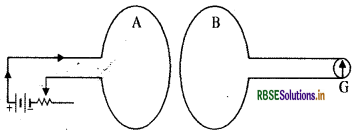
Answer:
When there is a change in amount of current, in coil A, then the magnetic field around A will also be changed. The lines of force from this field, while passing through coil B undergoes a change in the number of force lines in coil B because of which the induced current in coil be will also change.
What is a galvanometer ? Write its uses.
Answer:
A galvanometer is an instrument that can detect the presence of a current in a circuit. The pointer remains at zero (the center of the scale) for zero current flowing through it. It can deflect either to the left or to the right of the zero mark depending on the direction of current.
Define DC and AC current.
Answer:
1. DC current:

What do you mean by current rating ?
Answer:
Current rating means the maximum amount of current that flows through a fuse safely. If the current rating is 5A, it means that when the current exceeds 5A the fuse wire will melt.
Write any two differences between AC and DC current.
Answer:
|
DC Current |
AC Current |
|
1. Whether the amount of DC current changes or not its direction remains the same. |
The amount and direction of AC current changes periodically with time. |
|
2. Frequency of DC current is zero. |
In India, the fre-quency of AC current is 50 Hz. |
Answer:
- AC can be transmitted for long distances with minimum power loss, while DC cannot be transmitted for long distance.
- We can find any desired voltage from AC by the use of transformer.
- AC can be changed to DC easily when required by the use of rectifiers.
- AC can be controlled by using a choke coil. The use of choke coil minimises the energy loss while DC can be controlled by using ohmic resistances which involve huge energy loss in the form of heat.
- AC equipments are more convenient and durable than DC equipments.
- AC is more dangerous as compared to DC.
- AC always flows through the surface of a wire, this is called ‘skin effect’, while DC flows through whole cross-section of wire. Therefore, when a thick wire is required, a number of thin wires are used.
- AC shows only heating effect, and it does not show magnetic and chemical effects. Therefore, it cannot be used for electrolysis and construction of electromagnets.
Answer:
Answer:
- Armature: It is rotated on its axis.
- Magnetic field: Armature is placed in the middle of magnetic field.
- Sip-rings:They rotate along the armature.
- Brushes: They are made of metal or carbon. Current generated in the coil is taken out through the two brushes.
Answer:
- Current can be induced in a coil by rotating it in magnetic field between two poles of magnet.
- The current can be induced in a coil by .changing the current continuously in another coil kept near it.
- A current can be induced in a coil by keeping it stationary and rotating a magnet inside it.
Answer:

Dependence of electromagnet:
The strength of a electromagnet depends upon -
- Amount of current,
- Number of turns of wire, and
- Material on which coil is wrapped.
On what factors does the strength of magnetic field produced due to electromagnet depends upon ?
Answer:
The strength of magnetic field produced in an electromagnet depends upon -
- Amount of current flowing through the solenoid,
- Number of turns per unit length of the solenoid, and
- Material of the chord.
Strength of magnetic field can also be increased by changing the chord. The strength of soft iron cord is more than the strength of a steel chord.

What is short circuit ? What are the harmful effects of it ?
Answer:
When the live wire and neutral wire comes into direct contact, the resistance of the circuit becomes very small and a large current flows through the circuit which produces large amount of heat. Such situation is called short circuit.
Harmful effects of short circuit -
- Due to small resistance, the wires becomes extra hot and the insulation of the wires is damaged.
- Due to the removal of insulation, the wires becomes naked and hence possibilities of getting shock increases.
Differentiate between AC generator and DC generator.
Answer:
The differences between AC generator and DC generator are listed below -
|
AC Generator |
DC Generator |
|
1. It has two split rings. |
It has a commutator. |
|
2. It generates AC current. |
It generates DC current. |
|
3. It converts mechanical energy into AC current |
It converts mechanical energy into DC current. |
Answer:
|
DC Generator |
Electric Motor |
|
1.It is the appliance that converts mechanical energy into eletrical energy. |
It converts electrical energy into mechanical energy. |
|
2. It works on the principle of electromagnetic induction. |
It works on the principle |
|
3. In it, an induced e.m.f. is produced by rotating the coil in magnetic field. |
In it current is passed in the coil kept in magnetic field due to which coil rotates. |
What do mean by force on a current carrying conductor in a magnetic Held ? Describe it.
Answer:
An electric current flowing through a conductor produces a magnetic field. The field so produced exerts a force on a magnet placed in the vicinity of the conductor. French scientist Andre Marie Ampere suggested that the magnet must also exert an equal and opposite force on the current carrying conductor. The direction of the current flow, the direction of magnetic field and the direction of the force exerted on the conductor can be explained by Fleming’s left hand rule.

Show the following events through a line diagram -
(a) Deflection in compass needle on passing an electric current through a metallic conductor.
(b) Magnetic field around a straight conducting wire.
(c) Magnetic field lines of the field produced by a current carrying circular loop.
Answer:
(a)

(b)
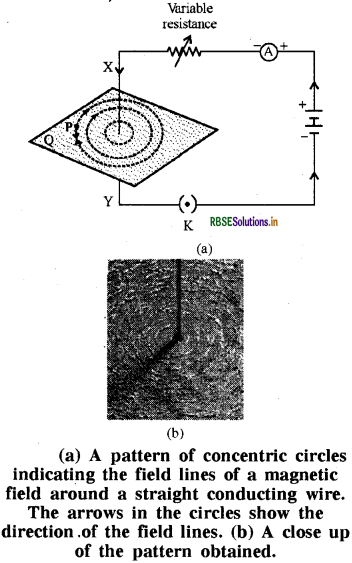
(c )
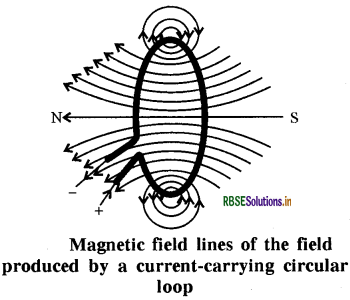
Draw a schematic diagram of domestic electric circuits and explain it. Describe the precautions in the use of electricity.
Answer:
In our homes, we receive supply of electric power through a main supply (also called mains), either supported through overhead electric poles or by underground cables. One of the wires in this supply, usually with red insulation cover, is called live wire (or positive). Another wire, with black insulation, is called neutral wire (or negative). In our country, the potential difference between the two is 220 V.

Electric fuse is an important component of all domestic circuits. A fuse in a circuit prevents damage to the appliances and the circuit due to overloading.
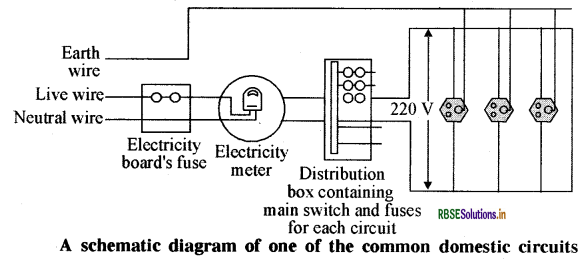
Precautions in the use of Electricity -
To avoid any accident like electric shock or electric fires, we should take some precautions as follows :
- If by chance any person touches the live wire, the main switch of the supply should be turned off as soon as possible.
- The fuse and the switch should always be connected in the live wire.
- A switch should not be touched by wet hands.
- All the electrical appliances that have a metallic body, for example, electric press, toaster, table fan, refrigerator, etc., should be earthed.
- The wiring used for household circuit should be of good quality.
- At the time of repairing, main switch of the supply should be turned off. If, however, it is necessary to handle a live wire then the working tool should be insulated properly.
Explain the following -
(i) Right-hand thumb rule.
(ii) Maxwell corkscrew rule.
(iii) Fleming’s left-hand rule.
(iv) Fleming’s right-hand rule.
Answer:
(i) Right-hand thumb rule:
This rule is used to find the direction of magnetic field associated with a current carrying conductor. According to this rule - “if the right hand holds a current carrying straight conductor such that the thumb points towards the direction of the current. The fingers wrap around the conductor in the direction of the field lines of the magnetic field.”
According to this if the crockscrew is driven in the direction of the current, then the direction of the rotation of corkscrew is the direction of the magnetic field.
According to this rule, “stretch the thumb, forefinger and middle finger of right hand so .that they are perpendicular to each other. If the forefinger indicates the direction of the magnetic field and the thumb shows the direction of motion of conductor, then the middle finger will show the direction of induced current.
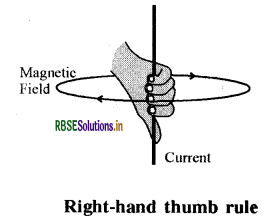
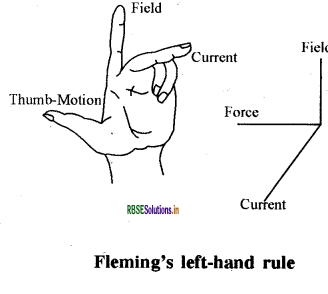
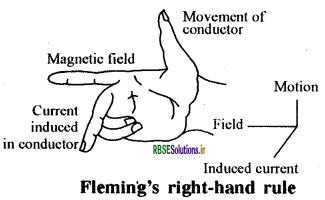

Explain the reasons for overloading or short-circuiting in domestic electrical circuits. Explain the harm caused by them and suggest ways to avoid them.
Answer:
Overloading can occur when the live wire and the neutral wire come into direct contact. (This occurs when the insulation of wires is damaged or there is a fault in the appliance. In such a situation, the current in the circuit abruptly increases. This is called short-circuiting.
Overloading can also occur due to an accidental hike in the supply voltage. Sometimes overloading is caused by connecting too many appliances to a single socket.
Harm caused by overloading or short- circuiting:
- Due to low resistance, the wire becomes hot and it results in the melting of the insulating material.
- When the upper cover is removed, the wires become bare, which can cause electric shock.
The use of an electric fuse prevents the electric circuit and the appliance from a possible damage by stopping the flow of unduly high electric current. The Joule heating that takes place in the fuse melts it to break the electric circuit.

- RBSE Solutions for Class 10 Science Chapter 12 विद्युत
- RBSE Class 10 Science Notes in Hindi & English Medium Pdf Download
- RBSE Class 10 Science Important Questions in Hindi & English Medium
- RBSE Solutions for Class 10 Science in Hindi Medium & English Medium
- RBSE Class 10 Science Important Questions Chapter 16 प्राकृतिक संसाधनों का संपोषित प्रबंधन
- RBSE Class 10 Science Important Questions Chapter 13 विद्युत धारा का चुम्बकीय प्रभाव
- RBSE Class 10 Science Important Questions Chapter 10 प्रकाश - परावर्तन तथा अपवर्तन
- RBSE Class 10 Science Important Questions Chapter 11 मानव नेत्र एवं रंगबिरंगा संसार
- RBSE Class 10 Science Important Questions Chapter 12 विद्युत
- RBSE Class 10 Science Important Questions Chapter 14 उर्जा के स्रोत
- RBSE Class 10 Science Important Questions Chapter 15 हमारा पर्यावरण